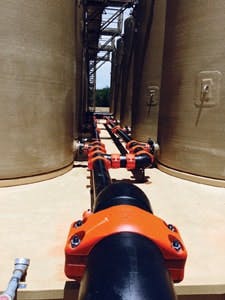About the author: Steve Cooper is a writer for SCA Communications. Cooper can be reached at [email protected].
Above: Crews move the lightweight HDPE pipe sections into place.
The Plastics Pipe Institute Inc. (PPI) named a new saltwater disposal (SWD) facility in northern Texas its Project of the Year for its Energy Piping Systems Division. More than 700 ft of high-density polyethylene (HDPE) pipe with mechanical couplers was used to connect 10 water tanks, two oil tanks, one gun barrel and three offload stations at the Atlas Resources Hamman Saltwater Disposal Facility.
Victaulic, a PPI member company and manufacturer of the couplings, received the award at the PPI annual membership meeting in May.
“This is a rather uncommon use of HDPE pipe,” said Tony Radoszewski, president of PPI. “It’s typical to see the pipe in water and gas applications, for example, but HDPE pipe is being found in more and more projects where its strength and resiliency are found to solve a problem. Being able to stand up to the highly corrosive nature of saltwater found in a project such as this is one attribute of HDPE pipe.”
Victaulic couplers were used to join sections of the HDPE pipe.
HDPE in the SWD Facility
SWD facilities have historically been constructed with plastic-coated steel, stainless steel or fiberglass. In designing the facility, which serves the company’s producing assets in the Marble Falls play, Atlas Resources engineers determined that HDPE pipe would be superior to metallic pipe, given the corrosion issues associated with saltwater. Compared to internally coated steel pipe, HDPE pipe also was a more economical choice, reducing material costs by more than 50%.
SDR 9 HDPE was selected for the facility piping, including the 10-in. gun barrel piping, 4- to 6-in. offload station, and 8- to 10-in. tank manifold piping. Nearly 100 Victaulic Style 908 couplings and 50 Victaulic Style 905 plain-end HDPE couplings were used, along with more than 50 valves and 20 equipment connections.
The original plan called for the pipe to be fused, but the fusion process presented several challenges. The tight spacing between the tanks, combined with the larger diameter piping, would have required some of the fusing to take place away from the tank battery, and for the spools to be hoisted in and mechanically joined. There also was a risk of the fusion equipment damaging the liner in the containment area. To overcome these difficulties, Atlas Resources decided to use the Victaulic HDPE pipe-joining system, which also was appealing for its ability to minimize time and labor on site.
The installation went well and the joining process was easy. According to the company, the Victaulic Style 908 can be installed in as few as five minutes, and a Victaulic Style 905 plain end unit can be installed in just two minutes.
“As to the ease of putting it together and the product itself, we heard nothing but positive reviews,” said Chris Fournier, senior facilities engineer for Atlas Resources.
SDR 9 HDPE was selected for gun barrel piping, offload station and tank manifold piping.
Joining in the Rain
Unfavorable weather conditions had the potential to derail the project. During the first week of assembly, the job site was hit with 15 to 16 in. of rain and high winds, resulting in serious flooding. Several inches of water had to be pumped out of the containment area daily. Rather than stopping work, crews were able to clear the water and continue installing the systems.
“The Victaulic process had no issues regardless of the weather conditions we were working in, whereas we would have had significant problems fusing. It was extremely fortunate that we were using this system,” Fournier said.
Construction stayed on schedule, and the SWD was completed in six days. Additional offload station piping was completed in four days, for a total of 10 project days, well ahead of the six-week projection for alternative joining methods.
In addition to the direct cost savings of HDPE over steel pipe, Atlas also saved on labor and materials by using the joining system.
“Having an extremely short construction window helped control labor costs in the field, especially given the weather we ran into,” Fournier said.
“The capabilities of the new Victaulic HDPE joining system make the use of HDPE pipe on such projects more approachable from a constructability standpoint,” said Randy Knapp, Ph.D., director of engineering for PPI’s Energy Piping Systems Division. “This is just one example of new markets and applications for plastic piping where alternative joining methods present limitations or difficulties. Other examples abound, and include applications in the water and wastewater, landfill and irrigation industries.
“These applications involve pipe installation in tight spaces, vertical orientations or on uneven ground,” he said. “The Victaulic HDPE joining system can be used in each of these situations without special accommodations, and also provides simple transitions to valves and equipment, easy access to the piping system for maintenance and visual verification of joint integrity, thus enhancing the appeal of HDPE pipe in such applications.”
The success on the Hamman SWD project has resulted in Atlas using HDPE pipe and the joining system on other projects, including a number of facility buildouts in the Eagle Ford Shale.
About the Author
Steve Cooper
Steve Cooper is a writer for SCA Communications. Cooper can be reached at [email protected].


